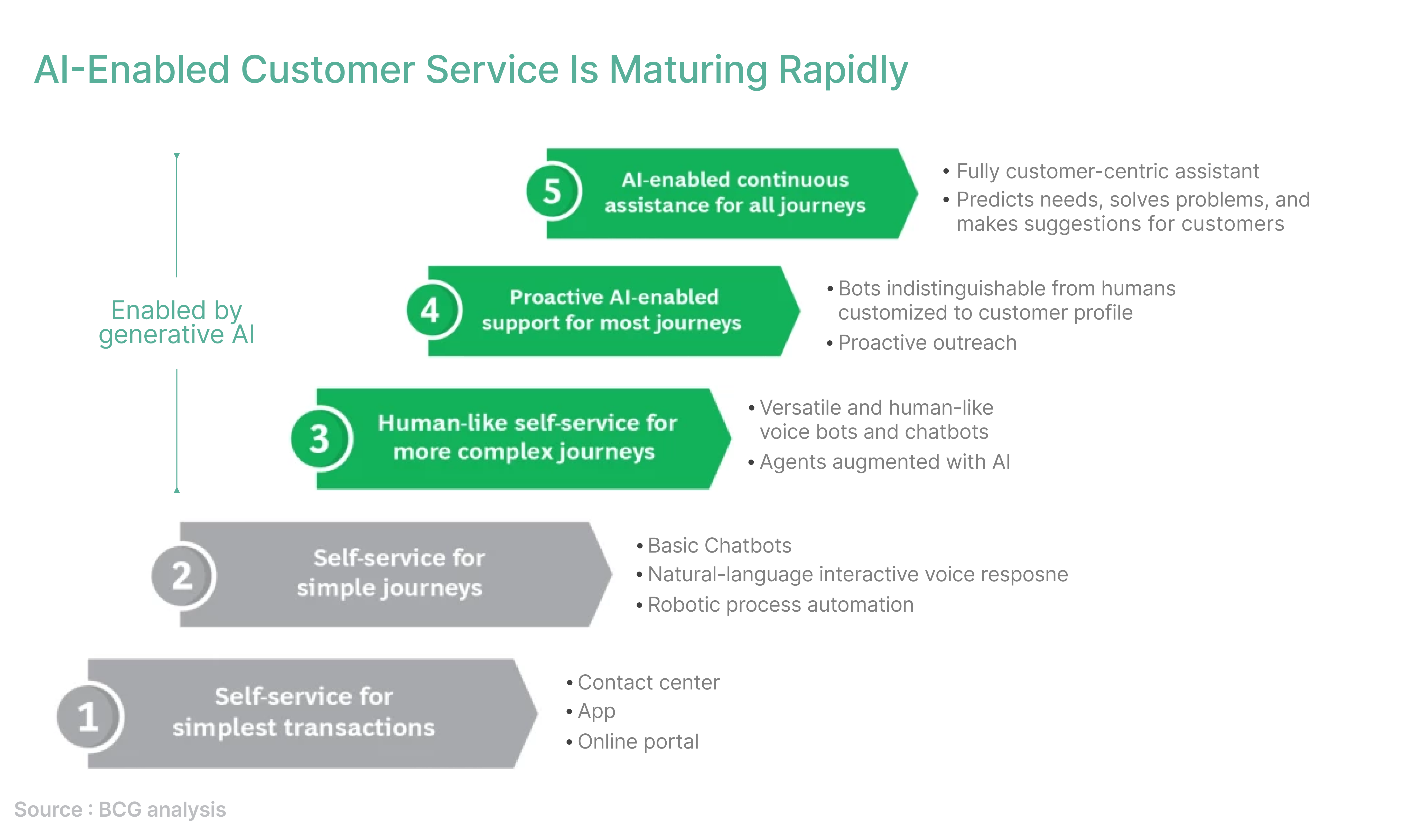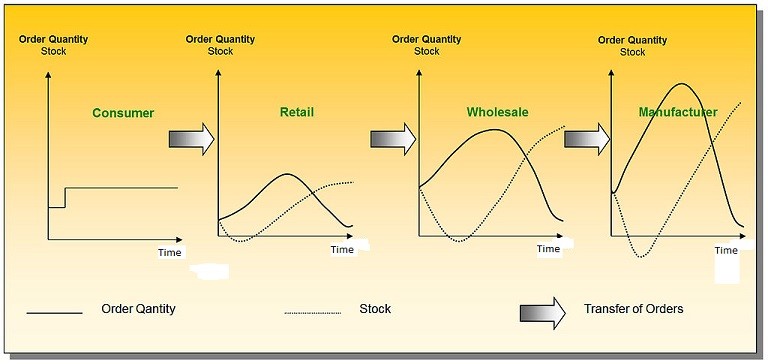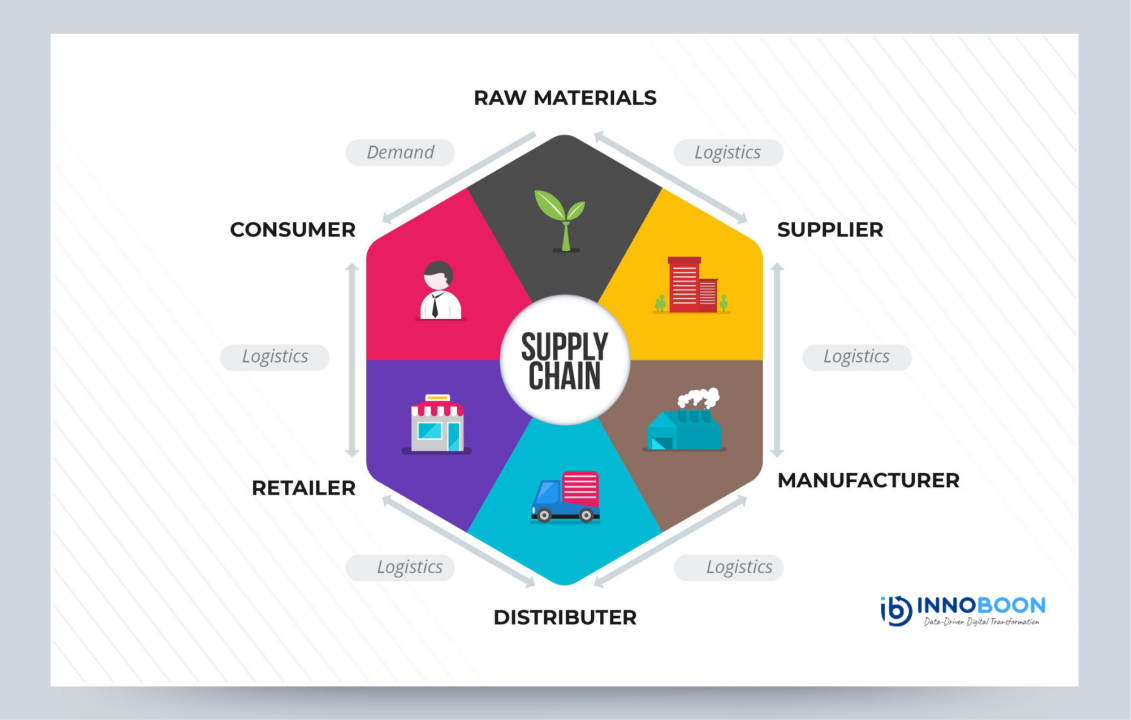Open AI’s ChatGPT and other generative AI applications are revolutionizing customer service operations across industries. These large language models (LLMs) have the ability to respond to prompts with human-like text and voice, providing sophisticated answers to complex questions. Generative AI has the potential to increase productivity by 30% to 50% or more when implemented at scale. According to a BCG survey, 95% of customer service leaders expect AI bots to serve customers within the next three years. However, challenges such as biases and inaccuracies in LLM-based chatbots remain. Companies are incorporating generative AI into their customer care functions, focusing on use cases that deliver the most value while ensuring human oversight. As generative AI matures, it will drive proactive problem-solving, personalized customer support, and deeper integration with other aspects of the business. The rapid advances in generative AI are transforming customer service functions, creating data-driven organizations that anticipate customer needs and deliver differentiated experiences Link to the article : https://www.bcg.com/publications/2023/how-generative-ai-transforms-customer-service #AI #GenAI #PredictiveAI #Customerservice #data #dataengineering #dataanalytics
The Supply Chain Industry was in the throes of multiple disruptions, with the lock downs forced on us by the pandemic, and the resultant steep variations in demand for goods. Most of the players in the supply chain domain were not ready for this disruption; the evidence was, and is, all around us. Sharp variations in demand for goods, resulted in: closure of manufacturing facilities rising cost of goods drop in availability of surface transport infrastructure drop in availability of skilled workers – truck operators and factory workers shipped goods, both consumer and parts meant for further manufacture and assembly, stuck aboard ships, for lack of adequate port infrastructure The impact: Demand forecasts gone awry Production schedules not adhered to Orders not delivered Rising costs and revenue loss Customers left disappointed Although there were abstract predictions about a virus that could cause a pandemic, by wise men, most companies did not perceive the predictions as serious. They did not expect that these disruptions could snow-ball into a major supply chain catastrophe. Complacency set in – the that-can’t-happen-to-me syndrome was voiced. But the supply chain bull-whip effect caught us unprepared. Variations in demand at the retail end of the supply chain, were accentuated and traveled up the chain towards the manufacturing end. Most companies failed to plan. They imagined that they could easily pull through, and be back to normal in no time. What practices can be adopt to mitigate the bull-whip effect: Diligently forecast demand Take into account lead times – time from order placement to delivery – while ordering Order less and more frequently – create a predictable routine Desist from conducting discount sales often Maintain prices – do not offer discounts on price. This too creates variation in demand The fundamental cause for the supply chain bull-whip effect is the lack of communication and flow of information. Now what? Here’s what we can do to make the supply chain “future-proof”: Plan – the activity that starts with analysis of the supply chain and proposing an appropriate system to plug the leaks, and lower stress in all the stakeholders along the chain Increase visibility – gather all available data and provide information and insights to decision makers Connect the silos. Establish real-time communications, including configurable alerts, among the various players in the supply chain, end to end Here’s where InnoBoon Technologies comes in to provide a one-stop supply chain planning and management solution – the Supply Chain Control Tower, along with prior consulting. What’s possible: End-to-end visibility of the entire supply chain A one-of-a-kind communications module that lets stakeholders and operators communicate in real time. Faster decisions contribute to dampening any rising bull-whip effect Clear, uncluttered, intuitive user interface that is easy to learn Initial consulting by experts provide optimum solution Support through the lifetime via easy maintenance contracts Get in touch.
Supply Chain Components The weakest link in a chain is where the first breakdown happens. Supply Chain Managers, have you figured out which is your weakest link? Let’s start with listing all the components of a supply chain: End-users, the customers – the people who enjoy the benefits of the product or service Last mile delivery – the entity that ensures the product or service reaches the customer Warehouses – large or small storage spaces where goods to be moved are aggregated for a short time Transporters – entities that provides facilities to move goods from one place to another – either from factories to warehouses, or warehouses to warehouses Factories – entities that manufacture goods from raw material or assembly products from raw materials or other parts Suppliers – entities that fulfil the raw material requirements of factories Suppliers’ Suppliers – entities that provide the raw material for next level of manufacture or assembly These are the top-level components. There may many sub-components that perform the same function of a top-level component. They are connected by demand forecasts, RFPs, contracts and agreements, indents, orders, warehouse inventory, shipping information, payments and receipts – all the information that is required to set up and run the chain. These are assisted by activities – product development, operations, marketing, distribution, finance, and customer service. What’s the problem? What’s the catch in this scenario? Imagine if these components of your supply work as independent entities. They work on their own and are only governed by the individual binding information between them. The retailer looks at previous sales figures and arrives at an approximate sales forecast – quantities and time frames. He does not communicate forecast figures, but batches orders, creating large order quantities, to tide over the coming season’s demand (that he has guesstimated). The factories, warehouses and transporters have not received these forecast figures. They do their individual assessments and arrive at their own forecasts. This results in: factories start production of the entire indented quantity, and fall behind warehouses are short of space for the incoming goods transporters do not have adequate vehicles The retailers are now unable to deliver because, either they run out of stock and have to cancel orders, if the demand spikes up or they have excess stock, and have to apply discounts to prices to clear stocks. There are many other scenarios – shipping breakdowns, calamities, inadequate infrastructure, etc. that can affect the supply chain and amplify the disruptions. What’s the solution? Champion the cause for an integrated system. Influence every player in the chain to get on board Drive efforts to chalk out the entire network, end-to-end. Bring in experts and consultants Define performance metrics, derived from desirable outcomes across the supply chain Build a plan to address normal operations and all foreseeable outlier occurrences and incidents, both short-term and long-term Extract, transform and load data (ETL) into a suitable platform to increase visibility across the supply chain Implement metrics tracking and reporting Enable near-instant communications among all key personnel, across the chain Use data and predictive analytics to assess and forecast consumer demand, with plans to manage drops and spikes in demand Execute the plan and review results periodically. Make adjustments in operations and metrics, if required Repeat step 9 What are the salient points in the above list? Adopt technology – data and predictive analytics, IoT, and make all the data visible Adopt a robust communication mechanism Plan, do, review, adjust, repeat At InnoBoon, our consulting practice is structured and is driven by purpose. The outcome of our consulting is a cost-effective, long-term solution that ensures a near-smooth supply chain, managed without stress.
Almost two-thirds (63%) of senior decision-makers working for large enterprises in the UK believe the current business disruption caused by a lack of access to or availability of raw materials or component parts in the supply chain will be resolved by the end of 2022. (source: https://www.logisticsit.com/articles/2022/08/16/large-uk-enterprises-in-denial-with-many-expecting-current-supply-chain-disruption-to-be-done-with-by-year-end) How are the large enterprises in the UK perceiving the supply chain disruption that reared its head during the pandemic? Let’s see what are the issues that have been with us for the past year or two. Non-availability: of raw materials and components, for manufacturing and assembly Shortage of supply chain skilled workers Shortage of infrastructure capability Lack of demand at the beginning of the lock downs, and demand spikes that surprised all at the end A survey shows that more than 60% of enterprises are hoping that this supply chain disruption will end by the time Christmas, 2022, rolls around. But, will it? More than 70% of the businesses surveyed are applying short-term measures, more like first aid, to mitigate this supply chain disruption. They are: sourcing more material from domestic suppliers increasing the number of suppliers keeping more stock in inventory These actions will keep the supply chain grinding along at severely lower efficiencies and will adversely impact the agility required for long-term sustainability and will add a myriad of complications to supply chain and logistics operations. While these enterprises are doing their best to address the supply chain issues, they are not being realistic about how long this supply chain disruption will last, and are responding with short-term fixes. The truth is that these supply chain disruptions will last for a long time, and future disruptions will appear at a faster, more accelerated pace, that would require enhanced agility and resilience. On the other hand, a few strategic thinkers have started enhancing their capability to withstand supply chain disruptions and improving supply chain management capabilities by adopting Technologies using data analytics and AI. Given the breakthroughs technology has brought in to help businesses with big data management, business intelligence, predictive analytics, and artificial intelligence, it is time all enterprises and SMEs in the logistics and supply chain domain look to moving onto intelligent technology platforms to derive maximum value from their existing capabilities and provide delightful experiences to their customers and end-users. We, at InnoBoon, have a one-point solution that is built on data analytics and AI technologies that is aimed at allowing businesses to tide over disruptions, and overall make it easy to manage the supply chain. The solution can be implemented and configured to fit the current model of all players in the supply chain and logistics space. InnoBoon also has acute Product Engineering capabilities to engineer and build bespoke solutions for managing logistics and the supply chain for all categories of stakeholders.






